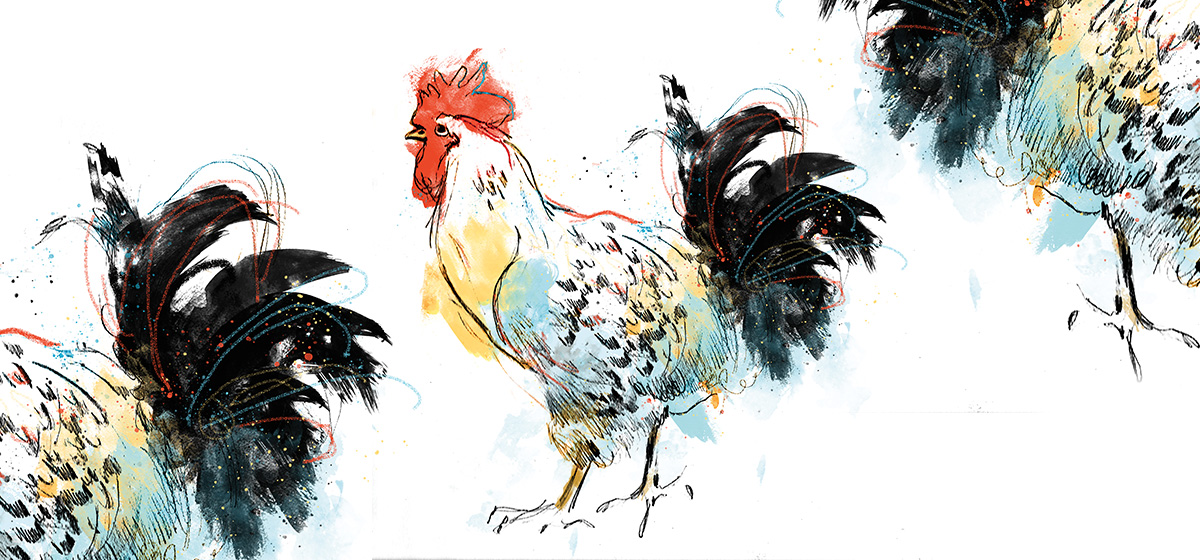Counting Your Chickens During COVID

Buff Cochins: sold out. Barred Rocks: sold out. Light Brahmas: Sold out. Not a hen of my choice available this year from Murray McMurray, the hatchery in Iowa where I’ve ordered peeps for 30 years. This has never happened before, but due to coronavirus, suddenly everyone wants to be a chicken farmer.
I had no choice but to hatch my own, so I separated a large, orange, furry-footed Buff Cochin rooster and four hens, put them in the barn in a horse stall with food, water, and nesting boxes—and hoped for a broody hen. My flock, which usually numbers 20–30 birds, had dwindled to nine, so I needed more layers—and a Cochin rooster. I’d also lost all my blue egg layers and wanted more; I was going to order green egg layers too. Little did I know how invested I’d become in the trials and tribulation of raising chicks.
When my daughter was young, our ritual was to peruse the Murray McMurray catalogue filled with chickens speckled, frizzled, spangled, booted, bearded, muffled, penciled, silver laced, combed, and high tailed. The odder, the rarer the breed the better. She’d pick her favorites, such as the White-crested Black Polish, which she named “Cheffy” because its white hair stuck straight up, resembling a toque. And we always included extra Buff Cochin pullets—and a Buff Cochin cockerel—because those are my husband’s favorite. We’ve had runner ducks too, African geese, and a turkey.
It’s been a year,” said Tom Watkins, who owns Murray McMurray with his wife and father-in-law. It’s been raising fowl since 1917 and also sells guinea hens, pheasants, peafowl, quail, and partridge. 2020 started out similarly to 2019, he said, until one week in March when calls went from the usual 500–600 a day to 1,600. “An astronomical amount,” he said. Egg layers and meat chickens were flying out of incubators for customers who feared food shortages, wanted to entertain and homeschool children, or simply desired to know their food’s origin. The hatchery usually sells a million birds a year; this year, it expects to sell 2.5 million.
The company ships birds from January through October. In colder months, the minimum is 25 (peeps keep each other warm during shipping) but by April, some breeds are available in groups of 15 or fewer. Chicks can survive without food for 72 hours because they are still digesting the yolks of their eggs.
My daughter and I went to the post office and picked up what she called “the chirping box,” filled with day-old peeps. We put them in a large, wooden box with a wire top to protect them from snakes and rats, fed them chick starter, and hung a heat lamp. The peeps grew quickly, scurrying across the barn floor, the children mesmerized, trying to identify which breed was which. (My daughter remembers our cat, sitting on the wire top, being rather mesmerized too…) But the journey can be difficult, and every year we lost a few, either upon arrival or a few days later. Still, Murray McMurray’s success rate at hatching and keeping peeps alive was far better than mine turned out to be.
Some years we didn’t get the chickens we ordered, such as when eight cute peeps grew into fighting cocks, chasing hens across the yard, attacking and sometimes killing them. As much as I hated doing it, I felt I had no choice but to round them up, have them slaughtered at the meat packer, and make chicken broth. Watkins admitted the fault may have been theirs, but explained that all peeps go through the Memphis airport and if a box falls open and peeps run around, they get thrown into any available box. Customers have remarked receiving ducks or turkeys they didn’t order, he said. “It’s not unheard of to mix things up.”
Back at our barn, no hen would sit. “Poultry geneticists have done a great deal to eliminate the natural tendency for laying birds to become broody,” wrote Leonard S. Mercia in “Raising Poultry the Modern Way.” Luckily, Buff Cochins are a broody breed, so I was hopeful.
To entice the hens, I placed straw in the nesting box and gathered the eggs into a circle, making the surroundings look suitably nest-like.
Human folly. No hen wanted any part of it.
Each of our chickens has had its own personality. Buffed cochins are gentle giants, bantams small and feisty, crested varieties spacey. When Cheffy’s crest got wet and hair covered its eyes, it spun in circles and didn’t know which way to the coop. Watkins explained why: the skulls of crested varieties don’t close until 6 weeks old, allowing hair to grow through the top of their heads. While fun to look at, they’re “kind of dumb,” he said. One of my favorite breeds is the Speckled Sussex, friendly and curious, always peeking into my scrap bucket to check out the day’s offerings.
Thirteen breeds of chickens existed in 1868, when, according to “Storey’s Guide to Raising Chickens,” by Gail Damerow, Charles Darwin published a chicken inventory. But today, there are 51 breeds of large chickens and 62 breeds of bantams, David Adkins of the American Poultry Association told me. Hens lay eggs every 25 hours, and egg color generally corresponds to a chickens’ earlobes (try locating a chicken earlobe). White-lobed chickens lay white eggs, and those with red earlobes lay brown. Old eggs float, and chickens love milk, which, in moderation, is good for them. Eggs have a coating called a “bloom,” a barrier against bacteria, so homegrown eggs shouldn’t be washed until ready to eat.
We’ve had chickens fly the coop, easy pickings for the fox, and chickens that roost in trees at dusk—owl food. When the children were young, we played “chicken lax,” reaching up into the branches with lacrosse sticks to nudge them off branches and into the coop. We’ve had chickens with crooked toes, crossed beaks, mean roosters who tried to use their spurs, roosters who fought each other, and some strange hens.
Cheffy was one strange hen—she crowed. “We have reports of hens that take on rooster attributes,” Watkins told me. “It’s not unheard of for a hen to crow.” Gail Damerow explained that hens in flocks with no roosters sometimes take on the male role—but we’ve always had roosters. Another explanation is that old or diseased hens may have underdeveloped ovaries, causing testosterone to enter the system, and the hen to crow.
Or perhaps Cheffy was a weak rooster. Sexing chickens, Watkins said, is a difficult and tedious task, and Murray McMurray hires professional sexers to do the job. (Vietnam, he told me, has the only technical college in the world that gives degrees in that subject.) The hatchery guarantees 90 percent accuracy, though he believes the numbers are closer to 95–98 percent.
Finally, one of our hens got broody. Then another hen got into the same box, and, with her head and beak, pulled four eggs toward her. Mama Hen pulled them back, and ended up sitting on 14 eggs. Even though one of my manuals says 12 eggs is maximum, Cochin hens are wide-breasted and she easily covered her clutch, so I let her be.
I became a mother hen of sorts myself, checking Mama Hen multiple times a day, bringing extra kitchen scraps, keeping the pen very clean, and spending more time than usual with the flock. Sometimes I just stood in a corner and watched: the rooster sound asleep; chickens grooming themselves; hens squawking and nipping at each other. One day I saw something I’d never seen before—a hen facing the wrong way in the nesting box. She began clucking and straining, and laid a large brown egg right in front of my eyes.
Chicken sounds have become such an integral part of this farm that I cannot imagine life without them. I love hearing roosters crow at dawn, and am always amused when cockerels learn to crow—a weak facsimile at first, sometimes just the cocka-doodle, and sometimes just the doo. Eventually they put it all together, but no two crows are alike. The clucking of egg laying goes on all day, and of course, there’s the alarm cry—when a predator is nearby. Our younger dog recognizes this sound as well, lifts her head and races across the lawn, jumps the stream, and up the hill to chase the fox. She’s the great chicken protector, even though the first thing she did the day we brought her home as a puppy was to kill a chicken. I heard the alarm sound one day when I was alone, ran out and quickly shut the chickens inside the coop, then walked the exterior of the fence to make sure the fox was gone. And there, in the corner of the fenced-in area, sat a large red fox. Luckily my neighbor returned at just the right moment, because it took two of us to maneuver the fox out without it attacking any chickens.
Poor chickens do have a plethora of creatures after them: owls and hawks from above, rats tunneling below, opossum hiding in the coop with them, fox, raccoon, mink, snakes, fishers, dogs and cats. Owls take the head and neck; fishers kill purely for sport; snakes eat eggs and chicks and leave no trace. “Everything likes chicken,” Watkins joked.
(Note to idealist coronavirus chicken farmers: Raising chickens is not always easy or pretty.)
New chicken farmers should choose large breeds, Watkins advised, such as Rhode Island Reds, Barred Rocks, and Buff Orpingtons—“the beginner’s best friends.” Keep the coop clean and give them plenty of space, he said, and be aware of a common disease called Coccidiosis, an internal parasite, which thrives in wet bedding in heat and humidity. My neighbor got salmonella from her peeps so always wash hands after handling them, and Watkins reiterated Center for Disease Control and Prevention rules that no one under 5 handle chickens, and don’t kiss them.
Waiting for the peeps to hatch seemed interminable to me and must have felt more so to Mama Hen. In the 21 days it takes to hatch peeps, brooding hens typically lose 20 percent of their body weight, and leave the nest for only 15–20 minutes a day. Each time I checked on her, she looked thinner and more disheveled. She pecked at me viciously when I removed her from her nest to check on her clutch.
Then one day, right on schedule, I walked into the stall and saw a tiny, beautiful yellow chick. The peep knew exactly which hen was its mama, and stayed closed at first, but eventually ventured out and learned to eat and drink, throwing its little head back when it did. Somehow new life in the time of COVID-19 seemed extra joyous.
I candled some eggs, and took away those I thought weren’t viable, but I am an amateur and it was not an exact science. A few days later when I lifted Mama Hen off the nest again, I saw pipping in an eggshell and heard a peep through the shell; mother and baby were communicating to each other even before the little one was born. But the next day, what looked like a perfectly healthy chick didn’t move, as if its legs didn’t work properly. My daughter was at the farm then and she and I contemplated removing the peep, but decided Mother Nature knew best. The next day it was dead, seemingly crushed. “Generally, you are better off in the long run to let Mother Nature take her own course,” said Adkins from the American Poultry Association, but now, of course, I wish I’d tried something.
I was in the barn at 6 a.m. the next morning checking on another egg on which I’d seen pipping. I didn’t want another one to die. But from this egg I heard no sound, and when it hatched it was barely alive, and didn’t look normal. A few hours later it was in the middle of the stall, dead. Two more deaths followed.
Finally, enough was enough. Mama Hen had been on the nest a week longer than necessary, and I removed all the eggs. “Hallelujah,” she seemed to say, sprinting off the nest to eat and drink and take a dust bath.
Now little Mili—named after my son’s girlfriend, born on the same day—is healthy and adorable, racing about and sitting on Mama Hen’s back, or under her wing, only her head peeking out. Her legs are getting long, her feet furry, and she’s growing tiny wing feathers a shade darker orange than her body. Mili is short for Milagros—our little miracle.





